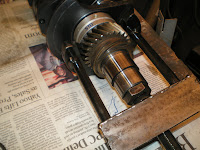
(Be sure to read Crank Basics - I
http://bobhooversblog.blogspot.com/2007/06/crank-basics-i.html )

- - - - - - - - - - - - -
As you can see in the drawing, the journal for the #3 main bearing is adjacent to the flange for the throw of the #2 connecting rod. Since the #3 main bearing is a full-circle bearing rather than a pair of shells, it is trapped on the crankshaft by the cam’s driver-gear and the distributor’s scroll gear, both of which are a shrink-fit. Pulling the gears off the crankshaft is a basic maintenance chore. The procedure is shown in the following photos.
I’ll be using a portable screw-type puller specifically designed for this task, the first step of which is to remove the pulley, dynamo rotor or whatever happens to be on the pulley hub. The oil slinger and #4 main bearing are then slid off the nose of the crankshaft. You’ll need a pair of special pliers to remo
 ve the snap-ring.
ve the snap-ring.
The #3 bearing should be free to slide back & forth on its journal. Doing so will reveal a gap about a tenth of an inch wide between the bearing and the cam gear. I you use an hydraulic press, the press-plate must fit into this gap. See the previously posted drawing for dimensions.

Whatever method of removal you elect to use, you most protect the nose of the cran
 kshaft. The usual method is to simply thread a pulley-bolt full depth so the head of the bolt contacts the crankshaft. Pulley-bolts come in a wide variety of lengths and head designs. You want to use the short type so that the stress will be transferred directly to the crankshaft and not to the threads.
kshaft. The usual method is to simply thread a pulley-bolt full depth so the head of the bolt contacts the crankshaft. Pulley-bolts come in a wide variety of lengths and head designs. You want to use the short type so that the stress will be transferred directly to the crankshaft and not to the threads.
With a suitable pulley-bolt in place, fit the puller into the gap under the cam gear and pull the gear using a suitable wrench.
When the gears are seriously tight you may have trouble holding the crankshaft whilst turning the puller. If you have a large vise with padded jaws (ie, lead or copper pads) you may find it handier to hold the crankshaft in the vise. If you plan on building more than a few engines you will probably make up a fixture to support the crankshaft. If you make it sturdily enough it will serve to hold the crankshaft while pulling the gears.

The first thing I do after removing the cam gear is to apply grease to its bore. This surface is usually free of oil. If left unprotected it’s liable to have developed a haze of rust by the time you are ready to re-assemble the crankshaft.
-R.S.Hoover

